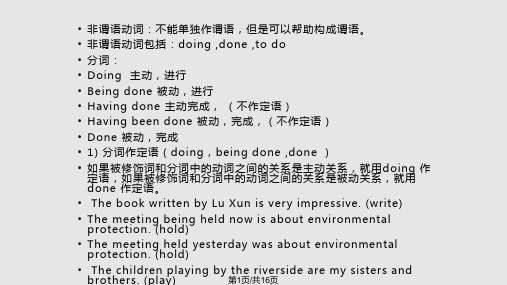非谓语动词用法精讲ppt
合集下载
非谓语动词课件用法全PPT课件

现在分词通常以“动词原形+ing”的形式出现,而过去分词 则以“动词过去式+ed”的形式出现。
分词的用法
分词的用法:分词在句子中可以作为主语、宾语、定语或状语,表示正在进行的 动作或存在的状态。
作为主语时,分词可以表示正在进行的动作或存在的状态;作为宾语时,分词可 以表示动作的承受者;作为定语时,分词可以修饰名词;作为状语时,分词可以 表示动作的方式、时间或地点。
PART 03
动名词
动名词的定义
总结词
动名词是非谓语动词的一种形式,表 示动作或行为的名词化。
详细描述
动名词是由动词变化而来,保留了动 词的词义和语法特征,但以名词的形 式出现,用于表示动作或行为的名词 化。
动名词的形式
总结词
动名词有一般式、完成式和被动式三种形式。
详细描述
动名词的一般式表示与谓语动词所表示的动作同时发生的动作;动名词的完成 式表示在谓语动词所表示的动作之前已经完成的动作;动名词的被动式表示被 动语态的动作。
WENKU DESIGN
WENKU DESIGN
2023-2026
ONE
KEEP VIEW
非谓语动词课件用法 全ppt课件
WENKU DESIGN
WENKU DESIGN
WENKU
REPORTING
https://
CATALOGUE
目 录
• 非谓语动词概述 • 不定式 • 动名词 • 分词 • 非谓语动词的特殊用法
总结词
详细描述
非谓语动词作状语,表示行为或状态的方式、 条件、时间等
非谓语动词作状语时,通常表示某个行为或 状态的方式、条件、时间等,对整个句子的 语气和意义起到修饰作用。例如:Walking in the park, I saw a beautiful butterfly. (在公园散步时,我看到了一只美丽的蝴 蝶。)
分词的用法
分词的用法:分词在句子中可以作为主语、宾语、定语或状语,表示正在进行的 动作或存在的状态。
作为主语时,分词可以表示正在进行的动作或存在的状态;作为宾语时,分词可 以表示动作的承受者;作为定语时,分词可以修饰名词;作为状语时,分词可以 表示动作的方式、时间或地点。
PART 03
动名词
动名词的定义
总结词
动名词是非谓语动词的一种形式,表 示动作或行为的名词化。
详细描述
动名词是由动词变化而来,保留了动 词的词义和语法特征,但以名词的形 式出现,用于表示动作或行为的名词 化。
动名词的形式
总结词
动名词有一般式、完成式和被动式三种形式。
详细描述
动名词的一般式表示与谓语动词所表示的动作同时发生的动作;动名词的完成 式表示在谓语动词所表示的动作之前已经完成的动作;动名词的被动式表示被 动语态的动作。
WENKU DESIGN
WENKU DESIGN
2023-2026
ONE
KEEP VIEW
非谓语动词课件用法 全ppt课件
WENKU DESIGN
WENKU DESIGN
WENKU
REPORTING
https://
CATALOGUE
目 录
• 非谓语动词概述 • 不定式 • 动名词 • 分词 • 非谓语动词的特殊用法
总结词
详细描述
非谓语动词作状语,表示行为或状态的方式、 条件、时间等
非谓语动词作状语时,通常表示某个行为或 状态的方式、条件、时间等,对整个句子的 语气和意义起到修饰作用。例如:Walking in the park, I saw a beautiful butterfly. (在公园散步时,我看到了一只美丽的蝴 蝶。)
非谓语动词用法精讲ppt

2 为了保持句子平衡,通常用先行词it作形式主语, 而把真正的主语放在句末。 It is no use crying over spilt milk. 作无益的后悔是没有用的。 It's a waste of time arguing about it. 争论这事是浪费时间。
必 背 动词-ing形式作主语的几个常用句型。 It‘s no good talking to him. 和他谈话是没 有用的。 It is useless telephoning him. He is not willing to come. 给他打电话没用。他不愿意来。 It‘s worth making an effort. 努力一下是值得 的。 There is no saying when it will stop raining. 无法断定这场雨什么时候会停。 There is no joking about such matters. 这种 事开不得玩笑。
主语 不定式 过去 分词
定语
宾语
表语
状语
宾语补 足语
×
×
v-ing 形式
• 3.语态:必须搞清逻辑主语 与非谓语动词的关系,从而 来确定非谓语动词态的语态。
A 动词-ing形式的一般式
1 动词-ing形式的一般式可用来泛指一个动作, 没有特别的时间意义。 Swimming is her favorite sport. 游泳是她最喜欢的体育运动。 Learning is important to modern life. 学习对现代生活很重要。 2 动词-ing形式的一般式可用来表示与谓语动词 同时发生的动作。 They went out of the classroom, talking and laughing. 他们有说有笑地走出教室。
非谓语动词用法精讲(完整版) (共133张PPT)

give us a lecture. 【正】The professor who came here yesterday will
give us a lecture. 昨天来的教授将要给我们作一个讲座。
The man coming here yesterday is a pianist. × The man who came here yesterday is a pianist. √
入不敷出。
a. 前置定语
单个动词-ed形式作定语一般放在被修饰的
名词之前,作前置定语。
A watched pot never boils. 心急锅不开。
All the broken doors and windows have
been repaired.
所有的坏门窗都修好了。
When we arrived, we each were given a
fantastic at the party that night.
A. recorded
B. recording
C. to be recorded
D. having recorded
③. The prize of the game show is $30,000 and an all
expenses _________ vacation to China.
和状语等成分。语态:必须搞清逻辑主语与非
谓语动词的关系,从而来确定非谓语动词的语
态。
精品PPT
分词
(一)现在分词与过去分词的区别 1、在语态上,现在分词表示主动,而过去分词
2、在时间关系上,现在分词表示动作正在进行, 过去分词指动作已完成 developing countries, developed countries
give us a lecture. 昨天来的教授将要给我们作一个讲座。
The man coming here yesterday is a pianist. × The man who came here yesterday is a pianist. √
入不敷出。
a. 前置定语
单个动词-ed形式作定语一般放在被修饰的
名词之前,作前置定语。
A watched pot never boils. 心急锅不开。
All the broken doors and windows have
been repaired.
所有的坏门窗都修好了。
When we arrived, we each were given a
fantastic at the party that night.
A. recorded
B. recording
C. to be recorded
D. having recorded
③. The prize of the game show is $30,000 and an all
expenses _________ vacation to China.
和状语等成分。语态:必须搞清逻辑主语与非
谓语动词的关系,从而来确定非谓语动词的语
态。
精品PPT
分词
(一)现在分词与过去分词的区别 1、在语态上,现在分词表示主动,而过去分词
2、在时间关系上,现在分词表示动作正在进行, 过去分词指动作已完成 developing countries, developed countries
非谓语动词超详细讲解ppt课件

动名词的形式
动名词既有普通形式,也有完成形式和被动形式。完成形式表示动作已经完成, 如having read;被动形式表示动作被承受,如being written。
动名词在句子中的成分
动名词也可以作表语,用来描述 主语的内容或性质,如Her job is teaching English.
动名词还可以作定语,修饰名词, 如a reading room, a swimming pool等。
非谓语动词超详用法与功能 • 动名词的用法与功能 • 分词的用法与功能 • 独立主格结构的用法与功能 • 非谓语动词的注意事项与误区
01
非谓语动词概述
Chapter
定义与作用
定义
非谓语动词是指在句子中不充当谓 语的动词,包括不定式、动名词和 分词三种形式。
独立主格结构的时态和语态
时态
独立主格结构的时态主要根据句子中的谓语动词来确定。如果谓语动词是现在时或将来 时,独立主格结构用现在分词;如果谓语动词是过去时,独立主格结构用过去分词。
语态
独立主格结构的语态分为主动语态和被动语态。当独立主格结构的逻辑主语与非谓语动 词之间是主动关系时,用主动语态;当逻辑主语与非谓语动词之间是被动关系时,用被 动语态。例如:“The problem being settled, we all felt relieved.”(问题解决了,
我们都感到松了一口气。)
06
非谓语动词的注意事项与误区
Chapter
非谓语动词使用时需要注意的问题
动词不定式、动名词和分词的区别
01
在使用非谓语动词时,需要根据语境和表达的逻辑关系选择适
当的非谓语动词形式。
时态和语态的正确使用
02
动名词既有普通形式,也有完成形式和被动形式。完成形式表示动作已经完成, 如having read;被动形式表示动作被承受,如being written。
动名词在句子中的成分
动名词也可以作表语,用来描述 主语的内容或性质,如Her job is teaching English.
动名词还可以作定语,修饰名词, 如a reading room, a swimming pool等。
非谓语动词超详用法与功能 • 动名词的用法与功能 • 分词的用法与功能 • 独立主格结构的用法与功能 • 非谓语动词的注意事项与误区
01
非谓语动词概述
Chapter
定义与作用
定义
非谓语动词是指在句子中不充当谓 语的动词,包括不定式、动名词和 分词三种形式。
独立主格结构的时态和语态
时态
独立主格结构的时态主要根据句子中的谓语动词来确定。如果谓语动词是现在时或将来 时,独立主格结构用现在分词;如果谓语动词是过去时,独立主格结构用过去分词。
语态
独立主格结构的语态分为主动语态和被动语态。当独立主格结构的逻辑主语与非谓语动 词之间是主动关系时,用主动语态;当逻辑主语与非谓语动词之间是被动关系时,用被 动语态。例如:“The problem being settled, we all felt relieved.”(问题解决了,
我们都感到松了一口气。)
06
非谓语动词的注意事项与误区
Chapter
非谓语动词使用时需要注意的问题
动词不定式、动名词和分词的区别
01
在使用非谓语动词时,需要根据语境和表达的逻辑关系选择适
当的非谓语动词形式。
时态和语态的正确使用
02
非谓语动词讲解ppt

ing 形式 主动 被动
过去分词 被动
一般式 to do
完成式 to have done
进行式 to be doing
to be done
to have be done
being done
having been done
done
分词 不定式作宾补用法要点 一 分词 不定式作宾语补足语的区别 1 感官动词see; watch; observe; look at; hear; listen to; notice 等和使役动词have 后面的宾补有三种形式;即原形动词不带to 的 不定式 现在分词和过去分词 现在分词表主动 或正在进行;过去分词表被动或完成;动词原形 表主动和完成 如: I heard her sing an English song just now I heard her singing an English song when I passed by her room yesterday
• ③ have sb do sth get sb to do sth 使/让 /叫某人去做某事
• 如:Mother had me go to the shop and buy some salt
• I can’t get him to stop smoking He won’t listen to me
• ③ The flu is believed to be caused by viruses that like to reproduce in the cells inside the human nose and throat
• 三 不定式 现在分词作宾补小窍门 • 下列动词后在主动语态中用不带to 的不定式作补
过去分词 被动
一般式 to do
完成式 to have done
进行式 to be doing
to be done
to have be done
being done
having been done
done
分词 不定式作宾补用法要点 一 分词 不定式作宾语补足语的区别 1 感官动词see; watch; observe; look at; hear; listen to; notice 等和使役动词have 后面的宾补有三种形式;即原形动词不带to 的 不定式 现在分词和过去分词 现在分词表主动 或正在进行;过去分词表被动或完成;动词原形 表主动和完成 如: I heard her sing an English song just now I heard her singing an English song when I passed by her room yesterday
• ③ have sb do sth get sb to do sth 使/让 /叫某人去做某事
• 如:Mother had me go to the shop and buy some salt
• I can’t get him to stop smoking He won’t listen to me
• ③ The flu is believed to be caused by viruses that like to reproduce in the cells inside the human nose and throat
• 三 不定式 现在分词作宾补小窍门 • 下列动词后在主动语态中用不带to 的不定式作补
非谓语动词语法详解ppt课件

entered.
A. reading
B. to read
C. to be reading D. being read
2. Do let your mother know all the truth. She
appears_____ everything. ( 01年高考)
A. to tell
B. to be told
Why not have a rest?
在句中承担的成分:
1. 作主语 2. 作表语 3. 作宾语
4. 作补语
5. 作定语 6. 作状语 7. 作独立成分 8. 与疑问词等连用
•关于时态
(1).They pretended not to see us.
(一般式表示与谓语的动作同时/在它之后发生.)
2.和你一起共进晚餐很愉快。
It is a pleasure to have dinner with you.
3.完成这项工程只花了二年时间。
It only took two years to complete the project.
(2). 表语 Predicative
To see is to believe.
A. To sleep B. Sleeping C. Sleep D. Having slept 2001春季高考 第21题
翻译:1935年,他离开家再也没回来。
In 1935 he left home never to return.
(7).独立结构
To tell the truth, I don’t agree with you.
make
feel
7.她觉得没有没有必要和他辩论。
She thought it unnecessary to argue with him.
非谓语动词用法总结PPT课件

• The meeting to be held next week is about environmental protection. (hold)
• 比较:
• The meeting being held now is about environmental protection. (hold)
brothers. (play)
第1页/共16页
• Seen from the top of the hill, the village looks even smaller.
• Seeing the village from the top of the hill, we find it even smaller.
第9页/共16页
• Keep +宾语+宾补 • Keep sb doing sth • Keep sb/sth done • Keep +sb/sth +adj. • She kept him waiting in the heavy rain. • She kept her mouth closed. • Have +宾语+宾补 • have sb do • Have sb doing • Have sth done • Make +宾语+宾补 • Make sb do • Make sth/sb done • Ask sb to do sth • He asked me to help him. • Advise sb to do • Allow sb to do • See sb do • See sb doing • With +宾语+宾补(doing ,done ,to do表示动作没做 ) • With so much work to do ,第he10c页an/共’1t6页go to the cinema with us.
非谓语动词用法精讲ppt课件

thoughtful, honest, bad, sensible,
naughty等。在“It is + 形容词 + for
sb + 不定式”结构中,形容词通常表示
事物的性质,如important, possible,
impossible, necessary, difficult,
hard, reasonable等。
but I’ m going to study in the U.S.A. this
September .
A.to be heard B.to be hearing
C.to hear D.to have heard
13
3.不定式作表语
What she wants to do most now is (to) travel abroad.
2
非谓语动词的句法功能
语法特征:在句子中充当谓语以外的 各种句子成分的动词叫非谓语动词,包括 不定式、动名词、分词(现在分词和过去 分词),他们没有人称和数的变化,但保 留动词的某些特征:有时态和语态的变化, 有否定式,可以带宾语、状语和补语;又 具有名词、形容词和副词的特征,在句子 中可充当主语、宾语、表语、定语和状语 等成分。
可充当成分: 主语, 宾语, 宾语补足语, 表语, 定语, 状语.
不定式各种形式的时间含义:一般式表示
动作或状态发生在谓语动词表示的动作或状态
的同时或之后;完成式在谓语之前;进行式强
调在谓语动词的同时;被动式是指主语是被动
关系,表示被动的动作。
8
1.不定式作主语
To lose your heart means failure.
I've got a lot of things to see to this morning. 今天上午我有许多事情要处理。 18
非谓语动词超详细讲解18页PPT

非谓语动词超详细革如果不讲纪律,就难以成功。
3、道德行为训练,不是通过语言影响 ,而是 让儿童 练习良 好道德 行为, 克服懒 惰、轻 率、不 守纪律 、颓废 等不良 行为。 4、学校没有纪律便如磨房里没有水。 ——夸 美纽斯
5、教导儿童服从真理、服从集体,养 成儿童 自觉的 纪律性 ,这是 儿童道 德教育 最重要 的部分 。—— 陈鹤琴
41、学问是异常珍贵的东西,从任何源泉吸 收都不可耻。——阿卜·日·法拉兹
42、只有在人群中间,才能认识自 己。——德国
43、重复别人所说的话,只需要教育; 而要挑战别人所说的话,则需要头脑。—— 玛丽·佩蒂博恩·普尔
44、卓越的人一大优点是:在不利与艰 难的遭遇里百折不饶。——贝多芬
45、自己的饭量自己知道。——苏联
3、道德行为训练,不是通过语言影响 ,而是 让儿童 练习良 好道德 行为, 克服懒 惰、轻 率、不 守纪律 、颓废 等不良 行为。 4、学校没有纪律便如磨房里没有水。 ——夸 美纽斯
5、教导儿童服从真理、服从集体,养 成儿童 自觉的 纪律性 ,这是 儿童道 德教育 最重要 的部分 。—— 陈鹤琴
41、学问是异常珍贵的东西,从任何源泉吸 收都不可耻。——阿卜·日·法拉兹
42、只有在人群中间,才能认识自 己。——德国
43、重复别人所说的话,只需要教育; 而要挑战别人所说的话,则需要头脑。—— 玛丽·佩蒂博恩·普尔
44、卓越的人一大优点是:在不利与艰 难的遭遇里百折不饶。——贝多芬
45、自己的饭量自己知道。——苏联
非谓语动词讲解课件-PPT(精)

C
2). Little Jim should love __________ to the A theatre this evening A. to be taken B. to take C. being taken D. taking A
4. 既可接不定式又可接动名词作宾语,但不定
式用被动式的形式;动名词用主动式的形式。 句子的意思没有差别。但句子得主语一般是 一表物的名词或代词。这类动词主要有: want、need、require等。 1) Your watch needs repairing \ to be repaired. 2) The windows need painting again \ to be
B
D
非谓语动词题的做题技巧
下面从二个方面来复习非谓语动词
1.非谓语动词的七大经典原则 2.非谓语动词解题四大步骤
一.非谓语动词的 七大经典原则
原则一:用作目的状语,原则上要用不定式
1.When asked why he went there, he said he was sent there _____ for a space flight. A. training B. being trained C. to have trained D. to be trained
非谓语动词的句法作用
非谓语 动词 不定式 动名词 现在分词
主语 √
宾语 √
表语 √
定语 √
宾补 √
状语 √
√
√
√
√ √
√
√ √ √ √ √ √
过去分词
非谓语动词的句法口诀
• 不定式本领强,六种成分都能当。 • 动名词不示弱,主宾表定用的上。 • 两分词互不让,表定状补争亮相。
非谓语动词用法精讲ppt

作状语
现在分词可以用来表示时间、原 因、条件等关系,如“Seeing
the cat, the mouse ran away.” (看到猫,老鼠跑了。)
作补语
现在分词可以在句中作为宾语或主 语的补语,如“I found him standing there.”(我发现他站在 那里。)
作定语
现在分词可以用来修饰名词或代词 ,如“the sleeping car”(卧铺车 厢)
被偷了。)
作定语
过去分词可以用来修饰名词或代 词,如“the stolen car”(被
偷的车)
05
非谓语动词的辨析与选择
Chapter
非谓语动词的辨析方法
01
动词不定式
表示动作尚未发生或 即将发生,常与助动 词连用。
02
动名词
表示动作已经发生或 正在进行,常与动词 原形连用。
03
现在分词
表示动作正在进行或 正在进行的状态,常 与助动词连用。
01 02 03 04
作宾语补足语
如“She asked me to help her.”(她叫我帮她。)
作定语
如“The book to read is on the table.”(要读的书在桌子 上。)
03
动名词用法ห้องสมุดไป่ตู้讲
Chapter
动名词的形式与特点
一般形式
被动形式
动名词的一般形式是动词原形+ing, 如reading、writing、swimming等 。
04
过去分词
表示动作已经完成或 被动接受的状态,常 与助动词连用。
非谓语动词的选择依据
根据句意选择合适的非谓语动词形式,如表示动作尚未 发生时选择动词不定式,表示动作已经完成时选择过去 分词等。 根据句子结构选择合适的非谓语动词形式,如需要强调 动作正在进行时选择现在分词,需要强调动作已经完成 时选择过去分词等。
现在分词可以用来表示时间、原 因、条件等关系,如“Seeing
the cat, the mouse ran away.” (看到猫,老鼠跑了。)
作补语
现在分词可以在句中作为宾语或主 语的补语,如“I found him standing there.”(我发现他站在 那里。)
作定语
现在分词可以用来修饰名词或代词 ,如“the sleeping car”(卧铺车 厢)
被偷了。)
作定语
过去分词可以用来修饰名词或代 词,如“the stolen car”(被
偷的车)
05
非谓语动词的辨析与选择
Chapter
非谓语动词的辨析方法
01
动词不定式
表示动作尚未发生或 即将发生,常与助动 词连用。
02
动名词
表示动作已经发生或 正在进行,常与动词 原形连用。
03
现在分词
表示动作正在进行或 正在进行的状态,常 与助动词连用。
01 02 03 04
作宾语补足语
如“She asked me to help her.”(她叫我帮她。)
作定语
如“The book to read is on the table.”(要读的书在桌子 上。)
03
动名词用法ห้องสมุดไป่ตู้讲
Chapter
动名词的形式与特点
一般形式
被动形式
动名词的一般形式是动词原形+ing, 如reading、writing、swimming等 。
04
过去分词
表示动作已经完成或 被动接受的状态,常 与助动词连用。
非谓语动词的选择依据
根据句意选择合适的非谓语动词形式,如表示动作尚未 发生时选择动词不定式,表示动作已经完成时选择过去 分词等。 根据句子结构选择合适的非谓语动词形式,如需要强调 动作正在进行时选择现在分词,需要强调动作已经完成 时选择过去分词等。
非谓语动词用法精讲ppt

② 既可用动词ing形式作宾语;也可用不定式作宾语
这类动词虽然既能用ing形式作宾语;也能用不定式作宾语;但用 法并不相同;主要有以下几种情况:
➢ 有些动词;如attempt; continue; hate; intend; like; love; prefer等; 后面接动词ing形式或不定式区别不是很大 They prefer spending/to spend their summer vacation in Dalian I intend to buy/buying an EnglishChinese dictionary
2 My aim is ______ go to Tsinghua University 3 One
C 动词ing形式作宾语
动词ing形式既可作及物动词的宾语;也可作介词的宾语
1 能用动词ing形式作宾语的及物动词可分两类;一类是只 能用动词ing形式作宾语;另一类是既可用动词ing形式作 宾语;也可用不定式作宾语
2 为了保持句子平衡;通常用先行词it作形式主语;而把真正的主语放在句
末
It is no use crying over spilt milk It's a waste of time arguing about it
必背
动词ing形式作主语的几个常用句型 It's no good talking to him It is useless telephoning him He is not willing to come It‘s worth making an effort There is no saying when it will stop raining There is no joking about such matters
非谓语动词语法讲解演示教学ppt课件.ppt

I prefer to stay at home today.(具体某次行为) He prefers walking to cycling.(惯常行为)
*一般说来不能用于进行时的动词如:realize, know,understand,see,lose等,多用不定式 如:I began to realize I had been wrong. We hate to lose the chance . Now we are beginning to see it more clearly.
being made going
having been made (不作定语)
having gone (不作定语)
made(表被动) gone(表完成)
to be made to go
to have been to have gone made
×
to be going
从使用情况来看,闭胸式的使用比较 广泛。 敞开式 盾构之 中有挤 压式盾 构、全 部敞开 式盾构 ,但在 近些年 的城市 地下工 程施工 中已很 少使用 ,在此 不再说 明。
语
to perform on. √
❖ 2. Having given her opinion about the building,
she left the meeting.
作
Having been used for a long time, the computer 状
needs repairing.
❖ 3. Having been used for many years, the bike needs repairing.
Having been told several times, 可以写成=Told several times,
*一般说来不能用于进行时的动词如:realize, know,understand,see,lose等,多用不定式 如:I began to realize I had been wrong. We hate to lose the chance . Now we are beginning to see it more clearly.
being made going
having been made (不作定语)
having gone (不作定语)
made(表被动) gone(表完成)
to be made to go
to have been to have gone made
×
to be going
从使用情况来看,闭胸式的使用比较 广泛。 敞开式 盾构之 中有挤 压式盾 构、全 部敞开 式盾构 ,但在 近些年 的城市 地下工 程施工 中已很 少使用 ,在此 不再说 明。
语
to perform on. √
❖ 2. Having given her opinion about the building,
she left the meeting.
作
Having been used for a long time, the computer 状
needs repairing.
❖ 3. Having been used for many years, the bike needs repairing.
Having been told several times, 可以写成=Told several times,
非谓语动词用法精讲完整版135页PPT

40、人类法律,事物有规律,这富 ❖ 丰富你的人生
71、既然我已经踏上这条道路,那么,任何东西都不应妨碍我沿着这条路走下去。——康德 72、家庭成为快乐的种子在外也不致成为障碍物但在旅行之际却是夜间的伴侣。——西塞罗 73、坚持意志伟大的事业需要始终不渝的精神。——伏尔泰 74、路漫漫其修道远,吾将上下而求索。——屈原 75、内外相应,言行相称。——韩非
非谓语动词用法精讲完整版
36、如果我们国家的法律中只有某种 神灵, 而不是 殚精竭 虑将神 灵揉进 宪法, 总体上 来说, 法律就 会更好 。—— 马克·吐 温 37、纲纪废弃之日,便是暴政兴起之 时。— —威·皮 物特
38、若是没有公众舆论的支持,法律 是丝毫 没有力 量的。 ——菲 力普斯 39、一个判例造出另一个判例,它们 迅速累 聚,进 而变成 法律。 ——朱 尼厄斯
高中英语非谓语动词讲解(共61张PPT)

注意: 不定式作定语若是逻辑上的动宾关系,不定式是不及
物动词的话,后应跟着一个相应的介词,但如果被修饰的是 place、time、way 就除外。 如:We must rent a house to live in.
That is a very good place to live.
在学习动词不定式的时候还有两点要注意哦!
1、“一感二听三让四看见”,要用省to的不定 式作宾补,但变为被动句时,要加上to, 如
e.g. 1)We hear him sing in the next room. He is heard to sing in the next room.
(feel, hear, listen to, see, watch, notice , look at, have , make, let)
What ∕ How about doing 做某事怎么样?
此tto doing sth.(盼望) pay attention to doing sth.(注意) be used to doing sth. (习惯于) prefer doing sth to doing sth (宁愿做某事而不愿做某事 ) devote to doing sth (致力于)
牛刀小试
1. My mother often asks me __D___ some cleaning on Sundays
区分下列词组:
see sb. doing/ do sth. hear sb. doing/ do sth. watch sb. doing/ do sth. notice sb. doing/ do sth.
感官动词 see, watch, look at, notice, hear, listen to, feel
物动词的话,后应跟着一个相应的介词,但如果被修饰的是 place、time、way 就除外。 如:We must rent a house to live in.
That is a very good place to live.
在学习动词不定式的时候还有两点要注意哦!
1、“一感二听三让四看见”,要用省to的不定 式作宾补,但变为被动句时,要加上to, 如
e.g. 1)We hear him sing in the next room. He is heard to sing in the next room.
(feel, hear, listen to, see, watch, notice , look at, have , make, let)
What ∕ How about doing 做某事怎么样?
此tto doing sth.(盼望) pay attention to doing sth.(注意) be used to doing sth. (习惯于) prefer doing sth to doing sth (宁愿做某事而不愿做某事 ) devote to doing sth (致力于)
牛刀小试
1. My mother often asks me __D___ some cleaning on Sundays
区分下列词组:
see sb. doing/ do sth. hear sb. doing/ do sth. watch sb. doing/ do sth. notice sb. doing/ do sth.
感官动词 see, watch, look at, notice, hear, listen to, feel
非谓语动词超详细讲解ppt课件

目的状语还可以用in order to或so as to来表示。
In order to pass the exam,he worked very hard. We ran all the way so as not to be late.
不定式也可以在作表语用的形容词后面作状语。
I am very glad to hear it. The question is difficult to answer. “too + adj/adv + to do”也作状语。 He is too old to do that. 另外句子中有enough这个词时,常用不定式作状语。 The room is big enough to hold us.
定式宾语放在宾语补足语之后,而用it作形式宾语。
I find/feel it interesting to work with him. My teacher made it a rule only to speak English in class.
Subject+ find/think/feel/make it +adj/n + to do sth. 6
组成谓语。
You ought to have been here yeste宾语或状语。
The Party called on us to serve the people . The students ran out of the classroom, laughing merrily .
完成形式
主动语态 to do to be doing to have done
被动语态 to be done
to have been done
- 1、下载文档前请自行甄别文档内容的完整性,平台不提供额外的编辑、内容补充、找答案等附加服务。
- 2、"仅部分预览"的文档,不可在线预览部分如存在完整性等问题,可反馈申请退款(可完整预览的文档不适用该条件!)。
- 3、如文档侵犯您的权益,请联系客服反馈,我们会尽快为您处理(人工客服工作时间:9:00-18:30)。
② 既可用动词-ing形式作宾语,也可用不定式作宾语
这类动词虽然既能用-ing形式作宾语,也能用不定式作宾语, 但用法并不相同,主要有以下几种情况:
有些动词,如attempt, continue, hate, intend, like, love, prefer 等,后面接动词-ing形式或不定式区别不是很大。 They prefer spending/to spend their summer vacation in Dalian. I intend to buy/buying an English-Chinese dictionary.
非谓语动词
1.性质:它具有动词的特点, 但在句子中起着名词、形容 词、副词的作用,充当主语、 表语、定语、宾语、宾语补 足语、状语的作用,即:除 谓语以外一切成分。
2.形 式
不定式相当于名词、形容词、副词。充当主语、宾语、
定语、表语、宾语补足语、状语。 动名词相当于名词充当主语、表语、宾语、定语。 分词相当于形容词、副词。作表语、定语、宾语补足 语、状语形成分
动词-ing形式的否定形式由not加动词-ing形式构成。 His not coming made everyone present very disappointed.
A 动词-ing形式作主语
1. 动词-ing形式可直接置于句首作主语。 Seeing is believing.= To see is to believe. 2. 为了保持句子平衡,通常用先行词it作形式主语,而把真正的主语放在 句末。 It is no use crying over spilt milk. It's a waste of time arguing about it.
主语 不定式 √ 表语 √ 宾语 √ 定语 √ 状语 √ 补足语 √
动名词
分词
√
×
√
√
√
×
√
√
×
√
×
√
3.语 态
必须搞清逻辑主语与非谓语动词的关系,从而来确定非谓 语动词态的语态。
不定式 to + v
表将来,主动。
非 谓 语 动 词
不定式的被动式 在表示被动的同 时还兼表示未来。
动词的v-ing
现在分词的完成式也表 示完成,尤其是表示有 明显先后时间关系的完 成。
Grammar Non-finite Verbs
TEACHER: MR LIU
1
哪些是动词的谓语形式?
找出各句的谓语动词并指出其具体形式 1. Don't teach fish to swim. 2. He had a good memory like an elephant. 3. It would be a waste of money building such a luxurious villa.
谓语动词和非谓语动词的判断
谓语动词和非谓语动词在高中英语教和学中具有重要意义,主要 表现在写作,语法填空和阅读长难句判断中。
例如:典型例子: There are many people stand at the gate. Standing 的误用
1.To get up early is good for our health.
表进行,主动
现在分词的被动式在 表示被动的同时还将 表示进行。
过去分词 v-ed
表完成,被动
A 动词-ing形式的一般式
形 式
1. 动词-ing形式的一般式可用来泛指一个动作,没有特别的时 间意义。 Swimming is her favorite sport. Learning is important to modern life. 2. 动词-ing形式的一般式可用来表示与谓语动词同时发生的动 作。 They went out of the classroom, talking and laughing. 3. 动词-ing形式的一般式有时也可表示在谓语动词的动作之前 或之后发生的动作。 I remembered sending him an e-mail last week. He suggested taking my daughter to the zoo the next Sunday.
成 分
必 背
动词-ing形式作主语的几个常用句型。 It's no good talking to him. It is useless telephoning him. He is not willing to come. It„s worth making an effort. There is no saying when it will stop raining. There is no joking about such matters.
B 动词-ing形式作表语
1. 表示主语的内容 Her job is keeping the lecture hall as clean as possible. 2. 表示主语具有的特征 The problem is quite puzzling.
1. Her work is ______( look )after the children. 2. My aim is ______( go ) to Tsinghua University. 3. One of my bad habit is ______(bite ) nails(指甲).
提 示 应尽量避免接连出现两上动词-ing形式。 I am starting to learn Russian. (√) I am starting learning Russian.
有些动词或词组后可带动名词或不定式作宾语,但意义 上有所不同。
come to do 表示一个渐渐发展的过程 I hope we shall be friends and come to understand one another. come doing 表示陪衬性的动作 It was already two o'clock when she came hurrying in. go on to do 做完一件事后,接下去做另外一件事 Having finished the exercises, we went on to learn the new words in the next unit. go on doing 继续做同一件事。 Though it was raining heavily, they went on working.
2.I want to get up early. 3.His dream is to be a teacher. 4.I see him singing. 5.Do you have something to say?
6.Singing and dancing, the students came into the classroom.
C 动词-ing形式作宾语 动词-ing形式既可作及物动词的宾语,也可作介词的宾 语。
1 能用动词-ing形式作宾语的及物动词可分两类,一类是 只能用动词-ing形式作宾语,另一类是既可用动词-ing形 式作宾语,也可用不定式作宾语。
①只能用-ing形式作宾语的动词(这类动词只能用-ing形式作
宾语,不能用不定式作宾语。)
B 动词-ing形式的完成式 动词-ing形式的完成式表示一个已完成的动作,这个动作发 生或完成在谓语动词表示的动作之前。 Having lived in this city for three years, she knows it very well.
点 津 坊
在现代英语中,作宾语的动词-ing形式的完成式可用一般式 来代替。 I really regretted missing such an exciting lecture. (=I really regretted having missed such an exciting lecture.)
Fancy meeting you here! I suggest doing it in a different wayd, miss, put off, postpone 建议完成多练习 →suggest, finish, practice 喜欢想象经不住 →enjoy, imagine, can't help 承认否定与妒忌 →admit, deny, envy 逃避冒险莫原谅 →escape, risk, excuse, 忍受保持不介意 →stand, keep, mind 词组有→admit to/prefer…to/ be used to /lead to /devote oneself to/ object to /stick to/ be busy /look forward to/(to为介词) no good\no use/It's worth… /as well as /can't help /It's no use \good/ be tired of/ be fond of /be capable of /be afraid of/ be proud of /think of\ about /hold off /put off/keep on /insist on/ count on \upon /set about/ be successful in /good at /take up /give up/ burst out /prevent … from…
Practice
1.He was in low spirits and even consider _____(go ) away. 2.Practise _____( put ) your hand to the ground. 3.I can‟t help ______( have ) the trip to Britain. 4.Don‟t tell me you always escape _____( fine) because you have a fast sports car. 5.Leave off ______(bite) your nails! 6.He didn‟t feel like ______( work ), so he suggested _____( spend ) the day in the garden. 7.You certainly mustn‟t miss _______( see ) the wonderful film. 8.The doctor advised ______( stay ) longer in hospital. 9.We appreciate your ______( want ) ______( help ) us in our difficulties. 10.Michael has delayed ______( write ) to her till today. 11.The law forbids ______( sell )liquor to children. 12.They all suggested ______( give ) more chances. 13.Can you imagine ______( leave ) standing outside for a whole night. 14.They built the banks to prevent the area from _______( flood).
